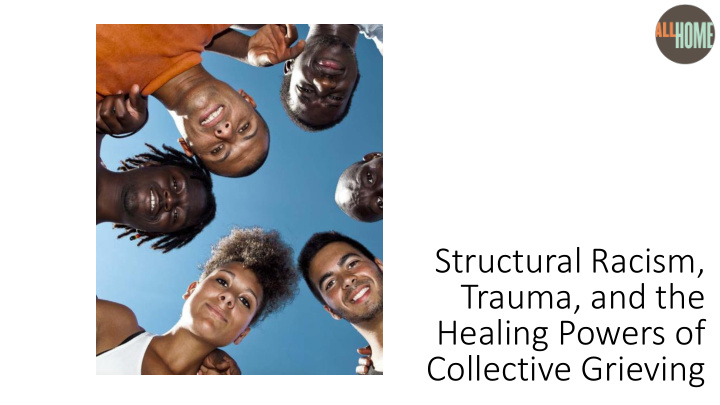



Structural Racism, Trauma, and the Healing Powers of Collective Grieving
Today’s Objectives • Participants understand the intersections and impacts of structural racism, trauma, and unprocessed grief • Participants understand the historical and contemporary manifestations of the aforementioned on client groups • Participants explore ways to address this need
My Story…
Race A specious classification of humans created by Europeans (Whites), using White as the model of humanity and the height of human achievement for the purpose of establishing and maintaining power and privilege.
Racism and Oppression • Race Prejudice + Power = Racism • Gender Prejudice + Power = Sexism • LGBTQ Prejudice + Power = Heterosexism
Historical & Contemporary Power Hierarchy Agent/Privileged Group Target/Oppressed Group Oppression White People of Color Racism Non-native Native Indigenous Colonialism Non-trans Men Women & Trans People Sexism Non-Disabled People differently abled Ableism Christian Other religions or ways of being Christian Hegemony Heterosexual Lesbian, Gay, Bi, Queer, etc. Heterosexism Adult Youth/Elder Ageism Wealthy Poor and Working Class Classism Citizen Non-Citizen Nationalism Formally Educated Non-formally Educated Elitism
Other Key Terms • Internalized Racial Oppression – Internalized Racial Superiority • Racial Hierarchy/White Supremacy/White Privilege/White Dominant Culture • White fragility/White Anxiety • Micro-aggressions – Internalized Racial Inferiority • Trauma • Stereotype Threat • Ethnocentrism • Model Minority Myth • Liberation & Cultural Pluralism
The Evolution of Race Relations Genocide Anti ti-Oppre ression Assimilation Diversity Colorblindness Enslavement Multiculturalism Racia ial Equity ity Segregation Bordering
Unconscious The human brain can take in 11 million pieces of information in any Bias one moment. We’re only consciously aware of maybe 40 of these – at best. Only 2 % of emotional cognition is available to us consciously Bias tends to reside in the unconscious network Messages can be framed to speak to our unconscious (Dog Whistle Politics) Mirror Neurons & Empathy
Consequences of implicit bias Bicycle Thief Video https://www.youtube.com/watch?v=6qMK-JSXawM
Lunch Time ☺☺☺
How do we Lead for Racial Equity & Social Justice?
Major Developmental Stages • Focus on Diversifying Organization and Systems → PEOPLE • Focus on creating an inclusive internal environment by transforming behavior, policies, and practices → CULTURE • Focus on integration of internal racial equity and social justice work by joining with others external to transform whole systems → SYSTEMS
How to get started… 1. Establish a shared understanding and vocabulary around race equity and structural racism 2. Identify race equity and social justice champions at all levels including board and senior leadership levels and establish interdepartmental team or taskforce to lead this work 3. Name race equity and social justice as a strategic imperative for your organization 4. Open a continuous dialogue about race equity and social justice work work 5. Disaggregate Data
The Role of Levers in Building an Equitable Culture: • Senior Leadership • Management • Boards • Community • Learning Environment • Data • Organizational Culture
Theory of Change To achieve functional zero : • People experiencing homelessness, particularly people of color, contribute to policy development and funding decisions • Local capacity is built through targeted training and technical assistance provided by leaders and trainers of color • Racial equity and social justice principles are integrated in all funding and policy decisions • System performance data is disaggregated by race and evaluated by outcomes for people of color experiencing homelessness • Policies and services are developed and implemented through a targeted universalism framework
Being an Anti-Racist Practitioner (Reflection + Action) Reflection • Socialization • Internalized Racial Inferiority/Superiority • Sharpening Analysis (Learning from History) • Developing Leadership • Using Racial Equity T oolkits • Conducting Power Analyses Action • Sharing Culture/Engaging Across Difference/Transcending Allyship • Check Your Privilege • Maintain Accountability • Recognize and Use your Role as Gate Keeper to Advance Racial and Social Justice
Dr. LaMont Green, DSW Lgreen@kingcounty.gov Thank You!
Recommend
More recommend